OCZ Vertex 3 Pro Preview: The First SF-2500 SSD
by Anand Lal Shimpi on February 17, 2011 3:01 AM ESTAnandTech Storage Bench 2011: Much Heavier
I didn't expect to have to debut this so soon, but I've been working on updated benchmarks for 2011. Last year we introduced our AnandTech Storage Bench, a suite of benchmarks that took traces of real OS/application usage and played them back in a repeatable manner. I assembled the traces myself out of frustration with the majority of what we have today in terms of SSD benchmarks.
Although the AnandTech Storage Bench tests did a good job of characterizing SSD performance, they weren't stressful enough. All of the tests performed less than 10GB of reads/writes and typically involved only 4GB of writes specifically. That's not even enough exceed the spare area on most SSDs. Most canned SSD benchmarks don't even come close to writing a single gigabyte of data, but that doesn't mean that simply writing 4GB is acceptable.
Originally I kept the benchmarks short enough that they wouldn't be a burden to run (~30 minutes) but long enough that they were representative of what a power user might do with their system.
Not too long ago I tweeted that I had created what I referred to as the Mother of All SSD Benchmarks (MOASB). Rather than only writing 4GB of data to the drive, this benchmark writes 106.32GB. It's the load you'd put on a drive after nearly two weeks of constant usage. And it takes a *long* time to run.
I'll be sharing the full details of the benchmark in some upcoming SSD articles (again, I wasn't expecting to have to introduce this today so I'm a bit ill prepared) but here are some details:
1) The MOASB, officially called AnandTech Storage Bench 2011 - Heavy Workload, mainly focuses on the times when your I/O activity is the highest. There is a lot of downloading and application installing that happens during the course of this test. My thinking was that it's during application installs, file copies, downloading and multitasking with all of this that you can really notice performance differences between drives.
2) I tried to cover as many bases as possible with the software I incorporated into this test. There's a lot of photo editing in Photoshop, HTML editing in Dreamweaver, web browsing, game playing/level loading (Starcraft II & WoW are both a part of the test) as well as general use stuff (application installing, virus scanning). I included a large amount of email downloading, document creation and editing as well. To top it all off I even use Visual Studio 2008 to build Chromium during the test.
Many of you have asked for a better way to really characterize performance. Simply looking at IOPS doesn't really say much. As a result I'm going to be presenting Storage Bench 2011 data in a slightly different way. We'll have performance represented as Average MB/s, with higher numbers being better. At the same time I'll be reporting how long the SSD was busy while running this test. These disk busy graphs will show you exactly how much time was shaved off by using a faster drive vs. a slower one during the course of this test. Finally, I will also break out performance into reads, writes and combined. The reason I do this is to help balance out the fact that this test is unusually write intensive, which can often hide the benefits of a drive with good read performance.
There's also a new light workload for 2011. This is a far more reasonable, typical every day use case benchmark. Lots of web browsing, photo editing (but with a greater focus on photo consumption), video playback as well as some application installs and gaming. This test isn't nearly as write intensive as the MOASB but it's still multiple times more write intensive than what we were running last year.
As always I don't believe that these two benchmarks alone are enough to characterize the performance of a drive, but hopefully along with the rest of our tests they will help provide a better idea.
The testbed for Storage Bench 2011 has changed as well. We're now using a Sandy Bridge platform with full 6Gbps support for these tests. All of the older tests are still run on our X58 platform.
AnandTech Storage Bench 2011 - Heavy Workload
We'll start out by looking at average data rate throughout our new heavy workload test:
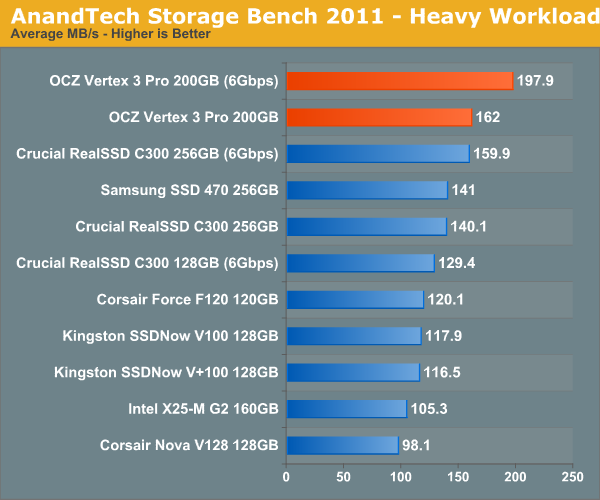
The Vertex 3 Pro on a 6Gbps interface is around 24% faster than Crucial's RealSSD C300. Note that the old SF-1200 (Corsair Force F120) can only deliver 60% of the speed of the new SF-2500. Over a 3Gbps interface the Vertex 3 Pro is quick, but only 15% faster than the next fastest 3Gbps drive. In order to get the most out of the SF-2500 you need a 6Gbps interface.
If we break out our performance results into average read and write speed we get a better idea for the Vertex 3 Pro's strengths:
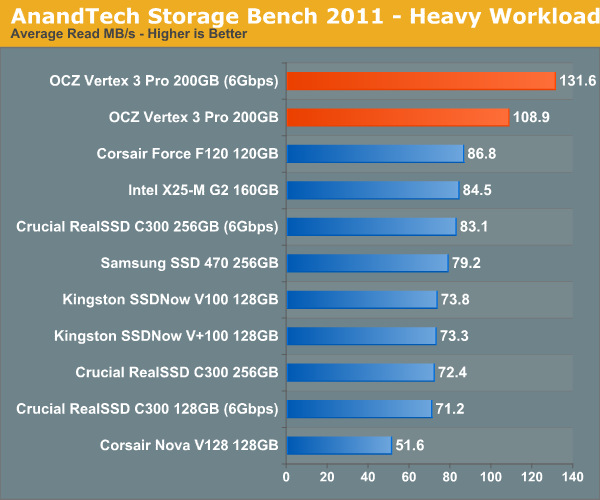
The SF-2500 is significantly faster than its predecessor and all other drives in terms of read performance. Good read speed is important as it influences application launch time as well as overall system responsiveness.
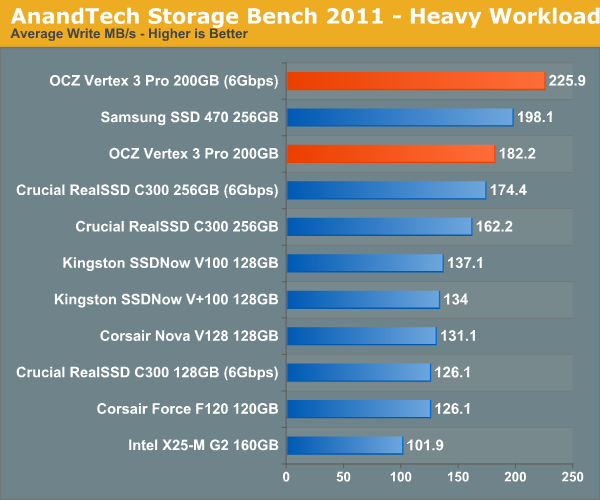
Average write speed is still class leading, but this benchmark uses a lot of incompressible data - you'll note that the Vertex 3 Pro only averages 225.9MB/s - barely over its worst case write speed. It's in this test that I'm expecting the new C400 to do better than SandForce.
The next three charts just represent the same data, but in a different manner. Instead of looking at average data rate, we're looking at how long the disk was busy for during this entire test. Note that disk busy time excludes any and all idles, this is just how long the SSD was busy doing something:
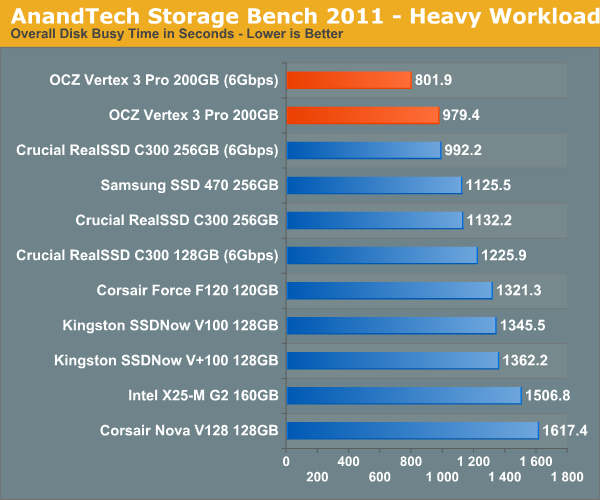
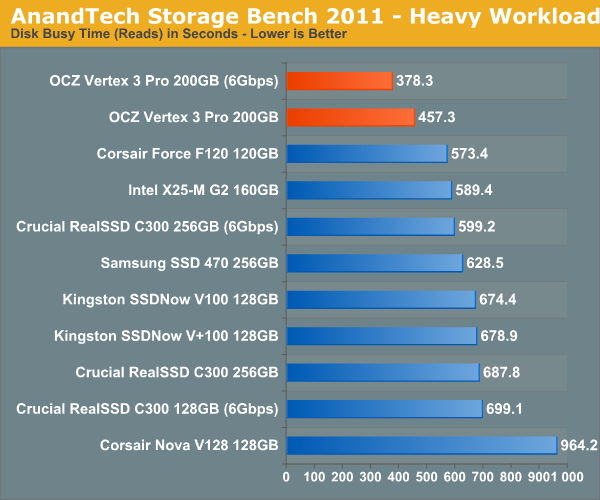


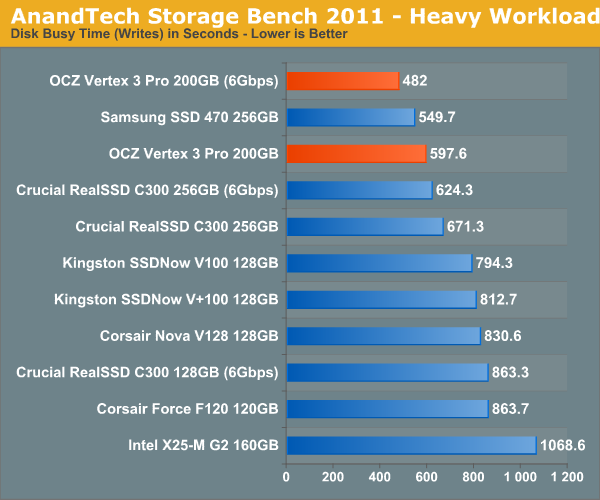








144 Comments
View All Comments
Slimline - Thursday, February 17, 2011 - link
This sounds interestingTrefugl - Thursday, February 17, 2011 - link
Indeed. I'm particularly liking the conclusion:'We're still a couple months away from knowing exactly what to buy, but if you've been putting off that move to an SSD - 2011 may be the year to finally pull the trigger"
That pretty much describes me perfectly. I do have an SSD in my work's workstation, but for home, but I've been holding out for 2011 (IMFT 25nm NAND) and I'm thinking I might not be disappointed by the wait.
Drag0nFire - Friday, February 18, 2011 - link
Indeed. I'm particularly excited to see what will happen when Intel shows up to the fight.MeanBruce - Friday, February 18, 2011 - link
Intel announced their 510 SSD G3 series today, it will come in 120Gb and 250Gb capacities, SATA3 6Gb/s, read/writes of 470Mb/s and 315Mb/s respect, and will be priced at $280 and $580! It's not using an Intel controller word is Intel doesn't have an in house controller with any real speed! SandForce is really shakin' things up! ;)MrBrownSound - Friday, February 18, 2011 - link
woah, no kidding. I'm looking forward to any reviews of it.MeanBruce - Saturday, February 19, 2011 - link
I knew when Intel pulled their G3 SSD lineup by rescheduling the release it had nothing to do with time constraints and everything to do with the numbers released shortly after by OCZ about their new SandForce controllers, 500/500 read/writes had Intel drawing up an entirely new gameplan for the new G3 lineup! But honestly I thought they would just let a little more magic out of the bag, I had no idea their bag was empty! Now I found out the new 510 series that becomes available March 1st is just going to use a Marvell controller just like the new Crucial and Corsair drives. I still love my X-25M but it's sad when a company with that many resources kicks back on their laurels. Oh well the good news is SandForce is here and with their new client Seagate we will have lots of choices and overall it's just great for the industry at large! Just sucks to watch the one time leader down so low!Out of Box Experience - Saturday, February 19, 2011 - link
Over 50% of the boxes on the Planet still run XPSo, the big question is...
Which one is XP compatible Out of the Box?
I'd love to buy a Sata 3 SSD that can saturate my XP Sata 2 ports but should we stick with Older/Slower Intel Sata 2 SSD's for compatibility??????
Any comment on this issue?
anactoraaron - Monday, February 21, 2011 - link
I know everyone has their own reason for keeping XP... but if you want to buy a $200+ SSD how can you not pony up the 100 for windows 7?Besides, 2 more years until XP is officially obsolete...
Out of Box Experience - Monday, February 21, 2011 - link
Bla bla blaHaving Windows 7 does not mean we all need to throw out our XP Licences and all our software that does not run on 7
Why can't somebody just answer my question instead of changing the subject
We get it! You love all the spyware and DRM built into Windows 7 but others don't
So lets just stick to the question I asked shall we?
Which Sata 3 SSDs will be Alignment agnostic at the very least so they can be used on ANY O.S. besides Spyware 7?
bennyg - Monday, February 21, 2011 - link
Bla bla bla spyware bla drm bla blaYou forgot to mention how locking DX10 to Vista/7 was a deliberate ploy to force gameplayers to upgrade.
And how Win7 is just Vista done right.
Far out some people hold grudges. I was ambivalent about Win7 when it was forced upon me - but for multicore + SSDs you just can't consider an old OS that wasn't designed when they were on the radar.